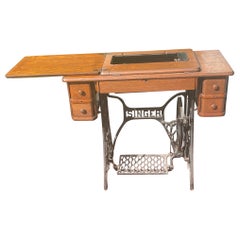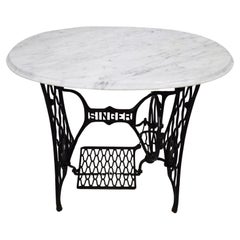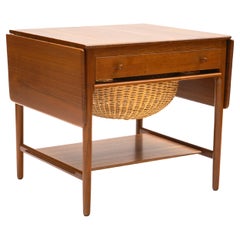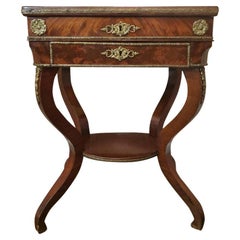Singer Tables
to
2
Height
to
Width
to
Depth
to
2
2
1
2
2
2
2
1
1
1
1
1
2
2
2
7
266
152
150
126
Creator: Singer
Vintage Singer Sewing Machine - Work Table
By Singer
Located in Cordova, SC
An antique oak sewing machine table with an iron base. As you can see in the first pictures it is of the table in the open position. The antique s...
Category
Early 20th Century American Arts and Crafts Singer Tables
Materials
Iron
$928 Sale Price
35% Off
Antique Singer Iron Table Carrara Marble Top
By Singer
Located in Lake Worth, FL
For FULL item description click on More Details below.
Shipping Quote Information
The shipping quote stated in the listing was from 1st Dibs and they normally set all the costs and ...
Category
Early 20th Century Steampunk Singer Tables
Materials
Carrara Marble, Iron
$1,196 Sale Price
20% Off
Related Items
Hans J. Wegner Teak At-33 Sewing Table
By Hans J. Wegner
Located in Kastrup, DK
Sewing table, model AT-33 in solid teak.
Features drop leaves, a wicker basket for knitting’s, and a drawer with spindles and divisions for thread and other supplies.
Designed by Ha...
Category
Mid-20th Century Danish Modern Singer Tables
Materials
Cane, Teak
19th C. French Charles X Restoration Period Sewing Stand Work Table
Located in Forney, TX
A scarce period Charles X (1818-1834) French Restoration mahogany travailleuse sewing (thread stand - side table - jewelry dressing table) with light, warm, beautifully aged patina.
Born in France in the early 19th century, almost certainly Parisian work, exquisitely hand-crafted, this exceptionally executed example features ornate gilt bronze ormolu mounts, escutcheons, and elaborate gilt metal trim. Having a highly figured light mahogany hinged lid top, lifting open to reveal a striking finished interior with divided compartments and original inset mirror plate. The conforming rectangular case fitted with a faux drawer front over a dovetailed drawer with sectioned interior. Elegantly rising on oval-shaped medial shelf stretcher-joined curvacious legs.
Dimensions (approx):
27" High, 20" Wide, 13.5" Deep
Stunning light almost blonde antique mahogany coloring and mellow warm tone, superb wood grain detail, and charming, beautifully aged patina over the whole. Great shape overall. Retaining original antique character marks, wear consistent with age and indicative of minimal use, nothing that detracts from the aesthetics or functionality, but only adds to the overall authenticity, refined elegant warmth, luxurious sophistication, and cozy unpretentious rustic elegance.
Delivered cleaned, hand waxed, polished French patina finish, ready for immediate use and generational enjoyment!
What is Charles X style:
The comte d’Artois – or Charles X - was the son of the dauphin Louis-Ferdinand de Franc and Marie-Josèphe de Saxe. He succeeded his two brothers Louis XVI and Louis XVIII and became the King of France in 1824. Thirty years after the French Revolution, he wanted to embody the return of monarchy and became the leader of the catholic party . As the previous kings, he was crowned in 1825 but he was soon overthrown by the revolution in July, 1830, called "Trois Glorieuses". He left then for England, Scotland, Prague and Istria where he died in 1836.
Charles X style lasted from 1818 to 1834 and happened during the Bourbon Restoration (French Restoration). This style did not replace totally the style of furniture from the French Empire but it was different from the formalism in the Napoleonic era, during which strictness and simplicity were inspired by Greco-Roman art. Indeed, artistic fields flourished. In terms of furniture, this renewal was suggested by the softening of shapes. Even though the simple aspect from the French Empire was still visible, shapes became curvier with volutes and arabesques. Another distinction is the loss of the massive aspect of furniture and the decrease of dimensions in order to decorate smaller appartments. Handling ability and comfort were key-words in the making of furniture. Apartments had essential elements such as chests of drawers, big rounded tables in the dining room, desks or secretaries, armoires and even dressing tables, comfortable fainting couches in the living room, small tables, pedestal tables, as well as gondola chairs. The wavy aspect of the latters certainly represent Charles X style the best.
One of the most emblematic features of this style is the use of bois clairs – light woods in warm blond tones - and indigenous woods that are varnished in order to highlight the grains. Bird's-eye maple, ash trees, plane trees, yew trees, beech trees, olive trees and cedar trees were most likely to be used. Indeed, at the beginning of the 19th century dark woods were hard to find. In 1806, the Napoleon’s Continental System was established in order to ruin the United Kingdom by preventing the country from any business with the rest of Europe. Therefore craftsmen had to find alternatives from mahogany which was the most commonly used material at this time. After 1815, the import of wood was even more difficult because of peace treaties and the European political situation, which contributed to the popularity of the bois clairs and indigenous woods. The furniture was often decorated with fine inlays made out of dark wood representing foliage, which contrasted with the veneer. Even though these patterns can look like bronze decorations from the Empire era, they were far more simple and did not represent any military or mythological attributes. On the tables, trays were sometimes made out of marble as in the French Empire, but it was often put aside and inlaid veneer, Verre Eglomisé – a type of glass with a mirror finish –, mirror or porcelain from Sèvres or Paris were more likely to be used.
Decorative elements from the Monarchy were highly appreciated again as they suggested luxury. Indeed, marquetry work was particularly fashionable - Boulle marquetry thrived around 1820 as the works of the Levasseur family can show. In the same way, draperies and trimmings referred to the monarchist splendour. Fabrics were often white – the traditional colour of the Bourbons – or light coloured as oppposed to the typical green from the Napoleonic era.
One of the most symbolic figures from this period of time might be Jean-Jacques Werner (1791-1849), a cabinetmaker who worked for prestigious clients such as the Duchesse de Berry who was Charles’s step-daughter. His works can be seen at the Musée des Arts Décoratifs and at the Grand Trianon in the Palace of Versailles. The duchess’s appartments situated at the pavillon de Marsan and at the Palais de Saint Cloud illustrate Charles X style the best with furniture made out of bois clairs and ornamented with dark wood patterns or fine gold decorations.
Chales X style allows a transition between the sobriety of the Empire style and the abundant aspect of Louis-Philippe style. The gothic style started at this time through the "style à la cathédrale", inspired by religious architecture, which thrived from 1827 to 1830. Indeed, at the beginning of the 19th century, Romanticism put the spotlight on the Middle Ages. Cabinetmakers were not inspired by the medieval furniture but rather by architectural elements of churches and cathedrals. For instance the backs of chairs were decorated with arches shaped like rib and serration. In the same way, before Charles X abdicated, pieces of furniture were made out of dark woods – such as mahogany, which was used again in France – and were inlaid with light wood. Romanticism also influenced the layout of furniture in appartments to suggest movement through a mix of various styles, various shapes and various sizes, as opposed to the static aspect of Neoclassicism. The start of industrialisation and mechanisation also influenced this style as early technical developments led to the production of pieces of furniture in series.
Credit:
Marc Maison
Bibliography:
FANIEL Stéphane (Dir.), Le Dix-neuvième Siècle Français, Collection Connaissance des Arts, 1957, Hachette
SASSONE, Adriana Boidi, Furniture from Rococo to Art Deco, 2000, Evergreen
--
Extremely versatile:
As warm and attractive as it is useful, this remarkable antique table having the ideal size and small proportions for a variety of different uses, including as a side table, accent or occasional table, tall sofa...
Category
Early 19th Century French Charles X Antique Singer Tables
Materials
Bronze, Ormolu
Antique Singer Cast Iron Treadle Sewing Machine Pink Marble Top Accent Table
By Singer
Located in Philadelphia, PA
Antique Singer Cast Iron Treadle Sewing Machine Pink Shaped Marble Top Accent Table. Foot pedal and wheel do work. Circa Early 20th Century. Measurements: 29.5" H x 33" W x 21" D.
Category
Early 20th Century Unknown Victorian Singer Tables
Materials
Marble, Iron
$950
H 29.5 in W 33 in D 21 in
Desk with Singer sewing machine
Located in Brescia, IT
Teak work table with flip top and sewing machine included. Three drawers are also present.
An original vintage Swedish desk that still features the Singer sewing machine inside. It...
Category
1960s Swedish Scandinavian Modern Vintage Singer Tables
Materials
Teak
20th Century Biedermeier Style Sewing Table
Located in Berlin, DE
20th Century Biedermeier style sewing table
Lyre sewing table in Biedermeier style.
Ash roots on solid pinewood.
(G-Gm-122).
Category
20th Century Biedermeier Singer Tables
Materials
Wood, Ash, Pine
George III Satinwood Sewing Table
By Thomas Sheraton
Located in Bradford-on-Avon, Wiltshire
Fine George III Sheraton Period satinwood sewing table; fitted top drawer, two candle slides and an ink drawer at the side; the back with a folding flap and an additional wooden hook...
Category
1780s English Sheraton Antique Singer Tables
Materials
Satinwood
French Cast Iron Marble Top Bistro Table
Located in Winter Park, FL
A French cast iron marble top bistro table with white painted patina. Base is sturdy and marble rests on top, unattached. Marble is old and not original to the base but fits perfectl...
Category
Early 20th Century French Beaux Arts Singer Tables
Materials
Marble, Iron
Antique Industrial Iron Hall Table from Singer, 1920s with Wooden Top and Base
By Singer
Located in Markington, GB
Exceptional quality stunning singer metal frame wooden hall table, this table could also be used as a desk, height is adjustable, wooden table top an...
Category
Early 20th Century American Industrial Singer Tables
Materials
Iron
$1,123 Sale Price
52% Off
H 33.86 in W 60.24 in D 21.66 in
Vintage Craftsman Oak Center Work Table
By Gerald McCabe, Lou Hodges
Located in Las Vegas, NV
A unique table that can be used numerous ways. Constructed of solid oak in the shape of an X or a Plus sign depending on how you view it, with a unique inlai...
Category
Late 20th Century American Craftsman Singer Tables
Materials
Oak
Cast Iron Singer Treadle Sewing Machine Base Console Table Oval Marble Top
By Singer
Located in Philadelphia, PA
Antique Cast Iron Singer Treadle Sewing Machine Base Console Table Oval Marble Top. Item features a thick oval white marble top, cast iron Singer treadl...
Category
Early 1900s Victorian Antique Singer Tables
Materials
Iron
$950
H 29 in W 48.25 in D 24.5 in
Hans Wegner Teak At-33 Sewing Table
By A.P. Stolen, Hans J. Wegner
Located in Brooklyn, NY
Danish Modern AT-33 sewing table, designed by Hans J. Wegner design for Andreas Tuck. A marvelous example of craftsmanship, this sewing table features drop leaves, a beautiful wicker...
Category
1950s Danish Scandinavian Modern Vintage Singer Tables
Materials
Teak
Octagonal Italian Pietre Dure Mosaic Inlay Carrara White Marble Table Top
Located in Marbella, ES
Octagonal Carrara White marble table top profusely decorated with Italian Pietre Dure mosaic inlays using green malachite, dark blue lapis, light blue turquoise, light green jade, mo...
Category
Late 20th Century European Singer Tables
Materials
Marble
$22,439
H 59.06 in W 59.06 in D 1.19 in
Singer tables for sale on 1stDibs.
Singer tables are available for sale on 1stDibs. These distinctive items are frequently made of wood and are designed with extraordinary care. Many of the original tables by Singer were created in the Arts and Crafts style in united states during the early 20th century. Prices for Singer tables can differ depending upon size, time period and other attributes — on 1stDibs, these items begin at $720 and can go as high as $720, while a piece like these, on average, fetch $720.
Questions About Singer Tables
- 1stDibs ExpertApril 5, 2022John Singer Sargent painted a number of notable people during the late 19th and early 20th centuries. Some of his most famous subjects include the writer Robert Louis Stevenson and U.S. Presidents Theodore Roosevelt and Woodrow Wilson. You'll find a range of John Singer Sargent art on 1stDibs.
- 1stDibs ExpertFebruary 27, 2024You can see John Singer Sargent paintings at a number of museums. The largest collection of the American artist's work is in the Museum of Fine Arts in Boston, Massachusetts. Other institutions that have Sargent's work in their collections include the National Gallery of Art in Washington, D.C.; Harvard Art Museums in Cambridge, Massachusetts; the Isabella Gardner Museum in Boston; the Art Institute of Chicago in Chicago, Illinois; the Museum of Fine Arts in Houston, Texas; and the Amon Carter Museum of American Art in Fort Worth, Texas. On 1stDibs, shop an assortment of John Singer Sargent art.
- 1stDibs ExpertNovember 26, 2024Yes, some Singer sewing machines are worth something. Select models like the 1939 Singer Featherweight with Crinkle Finish, the 1935 Singer "School Bell" Featherweight 221-1 and the 1956 Singer Featherweight 222K may sell for $2,000 or more when in excellent condition. Generally, the model, type, color and other factors will influence how much you might expect to get for a Singer sewing machine. Having the original packaging, instructions and accessories can also increase the potential selling price. If you'd like an estimate of the value of your Singer sewing machine, consider consulting a certified appraiser or experienced antique dealer. Shop a selection of Singer sewing machines on 1stDibs.
- 1stDibs ExpertSeptember 9, 2024How much a 50-year-old Singer sewing machine is worth varies. The model, age and condition all impact the potential selling price of collectible sewing machines. Pieces made 50 years ago would be considered vintage, and selling prices are typically in the hundreds or thousands of dollars for vintage models; machines in good working order are usually worth more than those needing repairs and restorations. A certified appraiser or knowledgeable antique dealer can examine your sewing machine and give you an estimate as to how much it may be worth. Explore a range of antique and vintage sewing machines on 1stDibs.



